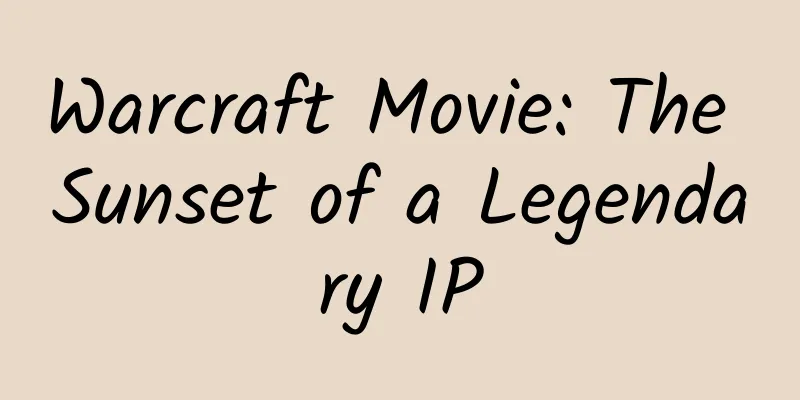Warcraft Movie: The Sunset of a Legendary IP

|
(Original title: Warcraft Movie: The Sunset of a Legendary IP) A game IP created in 1994 has earned $400 million in box office worldwide with the help of movies, surpassing the 316 million yuan of "Prince of Persia: The Sands of Time", a movie adapted from the game of the same name by Ubisoft in 2010, to become the first in the box office of game-adapted movies. It seems to have broken the curse that game-adapted movies are box office poison, but behind it is the lame progress of North American box office, which is still cold (currently only 37 million US dollars). What's interesting is that compared with the overseas hit of "Star Wars 7: The Force Awakens" at the beginning of the year (box office of 1.9 billion US dollars), China, which should have been the second largest box office in the world, did not perform well (116 million US dollars). Why do overseas IPs with the same huge worldview, long history and complex settings have different fates? The success of the "Warcraft" movie in China is based on the success of the MMORPG "World of Warcraft", and the success of "World of Warcraft" is based on the success of "Warcraft 3" in China. In short, the "Warcraft" movie is a victory of sentiment, but the Chinese have no sentimental support for the "Star Wars" IP. As for why China chose Blizzard and Warcraft, although both games are considered milestones in the gaming industry, the fact that they took root in China, became national games, and formed various social phenomena cannot be dismissed with this reason - there are too many milestones in the history of games, but they are meaningless to most Chinese players. Looking back, the success of Blizzard's Warcraft IP is inseparable from the domestic environment and gaming soil at the time - in fact, the popularity of all phenomenal works in China must be understood in combination with the background of the times and the special national conditions - just like "Legend" almost plagiarized Blizzard's "Diablo 2", and "World of Warcraft" was created based on SOE's "Everquest". It is not enough to consider the value of the game itself. Today, Lieyun.com will talk to you about the historical background of Blizzard's success in China, and the reasons why the World of Warcraft IP will eventually decline. About Warcraft IP and Blizzard Founded in 1991, Blizzard is a very interesting game company. Well-known stand-alone game companies that focused on PC platform development in the last century have now become fossils. For example, WESTWOOD, 3D Realms, ID Software, Eidos and other predecessors of Blizzard's generation have either transformed their business or been acquired by large companies. Basically, there are no more sequels with their own logos and appeal. Looking around, the only company that has adhered to the PC platform strategy and survived to this day with a healthy business and still has the strength to expand its territory in the industry, except for Blizzard, there may only be VALVE. Diablo has sold 19 million copies worldwide, but Chinese people are more familiar with its knockoff version, Legend. While other PC game manufacturers imitated the home console platform and only sold game software through retail channels, Blizzard took full advantage of the PC platform's hard disk media storage that can be continuously erased and rewritten, and continuously provided value-added services to extend the life of the game in a unique way, as well as how to provide more targeted online services (Blizzard's Battle Net) for game design under PC's strong networking (LAN and WAN). Although the core ideas of many Blizzard works are suspected of plagiarism (and players have also given them the nickname of North American Tencent), it must be said that Blizzard's sensitivity to the market and its grasp of game quality always make MADE BY BLZZARD better than its predecessor. In 2012, IGN selected Blizzard as the world's 50 greatest game developers, and Blizzard ranked only 8th. This certainly shows the strength of Blizzard, but it also indirectly shows that Blizzard is overrated in China. So why do Chinese people recognize the Blizzard brand? If we look back at the time before the rise of mobile games, the only countries in the world that insisted on playing games with a keyboard and mouse were probably South Korea, China, Eastern Europe, Russia, and some Eastern European countries. The mainstream of other countries was all dominated by the home console market. The year 2000 can be regarded as a node for Blizzard's development in the Chinese market. Before that, although Blizzard still had works such as "Diablo" and "StarCraft" that were well-known in China, the popularity of these works was only concentrated in a small group of players - after all, you know that when "Legend" entered China, not many Chinese people realized that it was a copycat of "Diablo" (core system and even interface). At that time, most of Blizzard's fans were concentrated on StarCraft and Diablo. The existing Blizzard fans in China (the so-called "Blizzard White") were mainly formed after 2000 and were directly linked to the World of Warcraft IP. Blizzard's success is not unrelated to the fact that the World of Warcraft IP can be enshrined. But looking back, the formation of the influence of the World of Warcraft IP was not the result of Blizzard's intentional operation in China. Warcraft 3 was released in 2002. At that time, Blizzard had not yet established a branch in the Asia-Pacific market to participate in direct operations and game distribution. All these matters were handed over to local agents (Songgang Technology in Taiwan and Ogilvy in mainland China). The success of Blizzard's Warcraft IP is inseparable from the right time, place and people after 2000. Weather factors: Game IPs in China have a mass base of Xianxia, martial arts and traditional literature. The fact that "World of Warcraft", which has a Western fantasy worldview setting, can stand out is a unique case in itself. Although the success of the game of the Warcraft IP is a comprehensive factor, the fact that it can quickly gain a foothold in the early stage of its release is inseparable from the shock that the "Lord of the Rings" trilogy brought to Chinese audiences from 2001 to 2003. When "Warcraft 3" was released in 2002, it happened to be the second part of the Lord of the Rings, "The Two Towers", which was a hit, and the whole world was influenced by Tolkien's Middle-earth world, the originator of fantasy literature. Although most people can't tell the difference between the Lord of the Rings and Warcraft (after all, the Internet was not well developed at the time), they still began to try to get in touch with Warcraft under the inspiration of the Lord of the Rings. There are many cases around me. However, the Warcraft IP is actually largely a reference and imitation of the tabletop game "Warhammer" that was popular in the 1980s. In the early stages of the development of "Warcraft 1", Blizzard, as a small company, planned to obtain Game Workshop's authorization for Warhammer (Blizzard's producer Patrick Wyatt once recalled this history in his blog, and many similarities in Warcraft can be used as evidence, such as the setting of green-skinned orcs only in Warhammer and Warcraft, and Tolkien's original setting of orcs was black-skinned, if you still remember the Lord of the Rings movie) to increase game sales, but failed to obtain authorization due to coordination issues between the two parties. Today, Blizzard should perhaps be grateful for this - slowly nurturing its own original IP instead of going to the grave with the sunset IP (Game Workshop terminated the "Warhammer" brand in July last year). Geographical factors: Since China’s ban on game consoles in 2001, the domestic home console market has almost completely given way to the PC game market. There are only a few overseas game companies that can develop their business normally in China. Blizzard’s ability to go against the tide during this window period is certainly related to the quality of its own games, but it is also inseparable from the fact that Blizzard games focus on online battles, especially LAN online battles. Because it happened that during this period, China’s Internet cafe industry began to rise, and at the same time, computers gradually became an affordable daily tool for college students, and dormitory LANs also began to become the norm on campus. The users of these two have something in common, and together they constitute the mainstream population of Chinese players. Foreign stand-alone games are all developed for personal computer users, and game saves are linked to local storage, which is why these game companies are not well adapted to China. E-sports games and online games do not require local saves. China's university dormitory network culture and Internet cafe culture are the biggest historical background for the rise of Blizzard games and online games. Old players around 30 years old must still remember "Game Stuff" At the same time, there was a window period before July 2004. A number of high-quality gaming TV media emerged in China, which had a profound impact on the spread of computer games, especially the rise of e-sports games such as "Warcraft". Among these programs were the pioneer "Game Stuff" of Travel Satellite TV, "E-sports World" of CCTV 5, and "Game Crazy" of Shanghai Lifestyle Channel. This batch of programs brought together a large number of young people. For example, "Game Stuff" had an average of 5 million regular young viewers and 20 million active viewers every day. Although the program took into account a variety of game types, the biggest beneficiaries at the time were probably "CS" and "Warcraft 3". Of course, it was also criticized by a member of the Central Committee of the Chinese People's Political Consultative Conference because it was too popular among students. From April to June 2004, the State Administration of Radio, Film and Television issued three gold medals in a row, completely strangling TV network game programs in the cradle. The short window period ended, but the pace of e-sports events could not be stopped. Human factors: The influence of WCG, which started in 2000, gradually spread to China. Although the CS team was the first to become popular, the concept of e-sports as a sport gradually took shape in the minds of young people in China, and a group of professional Warcraft 3 e-sports players with international standards emerged. From the early xiaoT, Shomaru, MagicYang to the later SKY, fly100% and the late th000, they became idols in the hearts of a group of young people. In 2005, SKY Li Xiaofeng won the WCG championship and won the first WCG championship in China on behalf of Warcraft 3. E-sports became a hot topic in society for a while - is e-sports a scourge? Of course, there were many WCG projects at that time, including the long-popular CS and the earlier StarCraft, as well as Westwood's Command & Conquer series and Red Alert series. Why did the Warcraft project rise so quickly in China? Apart from the factors of game graphics and the bonus of new games, it was also affected by the level of division in the e-sports field. The CS competition trophy has long been monopolized by European and American teams and there is no hope of a short-term breakthrough, while StarCraft is monopolized by Korean players. Only the level of Warcraft is relatively close to the global level, which gives Chinese players more opportunities and international competitions are more suspenseful and interesting. World of Warcraft, which was launched in 2004, was able to accumulate 600,000 players during the internal beta stage of the national server. On the one hand, it was due to the appeal accumulated by the World of Warcraft IP, and on the other hand, it was also related to the narrow offline social circle of the young generation in China at that time, and the lack of effective social channels for the same and opposite sexes. As a game with a good guild atmosphere and PVE system design, World of Warcraft requires cooperation and matching between different professions in the team to defeat the BOSS, rather than simply relying on the level and equipment of the players. Compared with other MMORPG games, it has stronger community stickiness. In the era when social networks were not well developed, World of Warcraft, which featured excellent PVE experience, emphasized the cooperation between players of different professions and levels during the process. The fact that World of Warcraft has become a large online chat room also shows that it is not only a game in China, but also a large social platform. The right time, right place and right people have made Blizzard's two Warcraft games gain unprecedented influence in China, a new continent with ever-changing market opportunities, and the popularity of the games has enhanced and amplified the game's IP. To be honest, when "Warcraft 1" was released in 1994, the game's world view setting was very mediocre. It almost adopted the basic settings of other fantasy IPs and lacked original settings. Although "Warcraft 2" has a richer world structure, it is not particularly outstanding compared to games of the same period. Both are produced by Blizzard, StarCraft and Diablo have not reached the heights of Warcraft in China, even though Diablo's sales are 6 times that of Warcraft. Why has the World of Warcraft IP gone downhill? Perhaps this sentence should be changed to "the appeal of the World of Warcraft IP is declining." Game culture is actually a kind of MEME culture. The core value of the World of Warcraft IP is attached to the game, community culture and the secondary creation of the fan community. The improvement of the IP value also needs to rely on new games to constantly stimulate the audience's inspiration. However, as carriers, "Warcraft 3" (RTS) and "World of Warcraft" (MMORPG) have a long history (launched/openly tested in 2002 and 2004), and at the same time, these two game types are becoming less and less suitable for the new generation of players. RTS can be said to be a slightly anti-human game type: it forces players to multitask. Players must take into account resource collection, base construction, troop construction, enemy scouting, harassment and other factors, and even multi-line micro-management to form basic combat strength. A Warcraft game is highly stressful for players, and consumes a lot of mental and physical strength. At the same time, the steep learning curve also makes the player's growth process extremely painful. Today, when the entertainment industry is becoming more and more developed and cheaper, games mean relaxation, rather than exhausting energy and physically and mentally exhausting the pursuit of challenges. As for MMORPG, with the development of social networks, the model that requires multiple players to meet in an afternoon or evening to complete a task for several hours is becoming less and less suitable for the change in social habits of most people in today's mobile Internet era, who use fragmented time to socialize. After all, with a variety of specialized social tools, people no longer need to rely on a game to meet interesting strangers. The era in the last century when people spent thousands of hours to familiarize themselves with the basic rules and command operations of a board game is becoming increasingly distant. For all types of games, the trend is for games to be "light" and processes to be "dumb". Therefore, Blizzard cannot attract more young players through "Warcraft 4" or "World of Warcraft 2", and the new popular game types, whether MOBA or TCG, cannot carry the overly large, heavy and obscure world view setting of the Warcraft IP. Therefore, whether it is "Heroes of the Storm" or "Hearthstone", Blizzard is continuing to overdraw the influence of the Warcraft IP, rather than extending its vitality. The reason why the World of Warcraft IP was able to continue to cause social phenomena in China in the past is that it has a group of young, creative and communication-loving fans who can constantly create new and vibrant cultural MEMEs through this IP, whether it is "Jia Junpeng", "Internet Addiction War", "Bronzebeard Gate" or the later "My Name is MT", etc. When these fans are no longer young and there is no fresh blood injected, the World of Warcraft IP will slowly become a fossil - just like countless game IPs that have been popular in history (who still remembers Tokimeki Memories today), and there are still some otakus who still regard the three heroines of Love Plus as goddesses. Was the Warcraft movie a success? It should be said that "film-game linkage" is not a new concept. The idea of games relying on film, television, comics and animation IP has existed since the beginning of games. For example, "ET", the infamous game in the history of game development that caused the "Atari SHOCK", is one of the cases. This kind of IP interaction has always been a way for games to unilaterally borrow IPs from comics, novels, and movies. Game IPs are rarely exported, even though the quality of game scripts is not bad in most cases. Except for a few phenomenal works, the influence and appeal of game IPs are limited. The game-adapted movies you can see are usually low-cost small productions by second-tier directors. Except for some that can recover costs, most of them are box office poison, which makes Hollywood even more afraid to touch game IPs. On the other hand, it is almost common sense for core game players to think that game-adapted movies are bad movies. Movies adapted from games either fail to please gamers or fail to please the box office, or even fail to please both. I can cite a bunch of such cases, such as the former, such as "Resident Evil" and "Silent Hill", and there are many works that fail to please both, such as "Dead or Alive", "Chun-Li", and "The King of Fighters". It is hard to say that "Warcraft", which was cold in North America but very popular in China, has really escaped this curse. There are several reasons why game adaptations are a minefield for the film industry: 1Other IPs such as comics and novels are mostly linear narratives, which can be easily converted into scripts for movies and TV series. However, this is not the case for all types of games. The narrative is often mixed in with the interaction of players. Screenwriters often cannot follow the original work and must re-grasp the rhythm and priority of the narrative. 2 Games can slowly outline the world view, and if the author is willing, they can even make all the characters full and full, so that there will be unexpected discoveries in each process of the game. But the time left for film and television works is only two hours for directors and audiences, so they can only choose one thread to tell the story clearly. 3. Games usually have complex side stories, even complex main stories, and multiple endings. For example, the endings of the human storyline and the orc storyline in Warcraft 1 and 2 are different, so the script may need to be rewritten. 4 Games can make the process interesting through interaction, but for bystanders, they lack a sense of novelty and many scripts and processes may be quite boring. This is the same as the fact that most of the time during a game live broadcast, bloggers have to rely on funny things to motivate the audience. 5 Compared with the situation where the original IP is a novel or animation, the threshold for experiencing the original work of a game IP is relatively high, so it is easy for the entire crew to fail to grasp it well. 6 In order to cater to the market, screenwriters will use the usual routines of commercial blockbusters in their movies. For example, in order to make "Warcraft" have a love element, Garona and Rosa are forced together. For example, the portrayal of Rosa's unruly character is not as good as the deliberately inserted "humor" of turning into a sheep to steal a key, as well as the useful family elements of blockbusters (Master Rosa), and the sense of responsibility of the superiors (King Llane's inexplicable self-sacrifice). The Warcraft movie is based on the game script of Warcraft 1, and incorporates the official novel Lords of the Clans and the story of the game history of The Last Guardian. Fans may enjoy watching it (in fact, the time point is when the Alliance has not yet been established and the Horde is still in the old Horde, so ordinary players need to rely on the setting collection and official novels to understand it), but for ordinary audiences, there are still problems such as weak character creation, vague clues, and unclear settings. In the movie, King Llane is in his prime, but in the manual that comes with the first game, he is a potbellied old man. The eating setting is not a good habit and is quite unfriendly to old players. The success of the "Warcraft" movie not only illustrates the success of the Warcraft IP in China, but also does not produce any groundbreaking results in exploring the profit model of game-adapted movies. Of course, fans are very happy with it (after all, there were 5.5 million active gamers in the peak period of World of Warcraft in China, and there are certainly more players who have joined the game one after another). For them, the game settings are already familiar to them. The most convenient thing for fans to create movies, comics, animations, novels, and even fan works is that they don’t need to set up a world view or create character images from scratch, and all their energy is focused on the development of the plot. According to an old World of Warcraft player on Zhihu, even if the World of Warcraft logo is played for several hours in a row, he will buy a ticket to watch it. On platforms such as Douban, IMDB, and Zhihu, the war of words between World of Warcraft fans and film critics and ordinary audiences can reflect the loyalty and feelings of fans, but on the one hand, such conflicts are a damage to the public image of fans - they fail to stand up for the feelings of fans, but force fans to defend themselves. The movie did not pass on the Warcraft IP to non-players, and non-players would not try to understand the culture and background settings of Warcraft after watching this movie. Judging from the box office, the Warcraft movie was undoubtedly successful in the Chinese market, but it overdrawn the fans' feelings. From the perspective of IP survival, it was undoubtedly a failure, at least it would not attract non-players to join the pit like the Lord of the Rings trilogy. The value of super IP lies in the shoulders of giants, and everyone is a participant If a super IP is defined as a powerful cross-domain monetization capability, then the biggest cost of building a strong IP is still time. Whether it is Warcraft, the Marvel Universe, or the Chinese Three Swords (except Gu Jian Qi Tan) IP, Japan's Touhou fan fiction and AKB48, each IP needs to go through a cycle from birth to maturity that ranges from five years to ten years or even decades - on the one hand, the main creative team needs time to slowly polish the work, and on the other hand, the core fans need time to digest the IP itself and build their own community. Core fans, especially the first batch of core fans, are valuable assets. The activity and level of core fans (education level, secondary creation ability, etc., if there are a group of masters and masters among the core fans (such as the first batch of well-known fan artists of KanColle)) determine the early explosive power of IP and the talent pool needed in the IP expansion stage (such as Tian Jian, the founder of Azeroth National Geographic, was a loyal fan of Blizzard in his early years). It is precisely because World of Warcraft once had a group of core players who could talk eloquently, talk about astronomy and geography, quote classics, write popular articles, and write funny jokes that the game society can grow explosively. For games, works are the source and destination of all meme inspiration. If there is no continuous generation of fresh content, memes, derivatives, and interesting memes and slogans will all run dry. Judging from the Japanese doujin miracle Touhou Project, although not every Touhou fan has played the Touhou doujin barrage game, without the god ZUN releasing new works at a rate of almost one per year, constantly providing new characters, settings, and BGM so that the fan community has new things to talk about, game players have new works to play, doujin artists have new characters to create, and fans have new memes to spread, otherwise Touhou's doujin creations would never have been popular throughout the Japanese doujin community and the global otaku circle for ten years. If you just want to cash in on IP, you must do it when the IP is hottest. Your success is just a matter of following the trend. In the three years when the Lord of the Rings trilogy was the hottest, EA's official games The Lord of the Rings: The Two Towers and The Lord of the Rings: The Return of the King, which were authorized for movie adaptations, sold 4.95 million and 4.42 million copies respectively, while subsequent Lord of the Rings-themed games often sold less than 1 million copies. Today, no player will still think about or miss these two games, because the factor that determines your success is the current popularity of the IP - it comes and goes quickly. If you think you can control the IP and take it to a higher level, then you can do it at any time. As long as you think the IP is good enough, you can ignore the current popularity of the IP. For example, when Peter Jackson filmed the movie "The Lord of the Rings", it was three or four generations away from the original book published in 1917. For example, the 2014 TGA (no relation to Tencent) annual best action game "Middle-earth: Shadow of Mordor" sold more than 5 million copies at a time when there was not much support from the original book. Many of my friends and colleagues are playing it (my computer configuration is not enough, so I can only think about it for now). Just like a monkey moving a stone, everyone is a participant and everyone wants to save effort, so the IP's reputation will be ruined sooner or later, let alone growing into a super IP. Super IPs also have their end, don’t think that it’s a waste of money Super IPs also have their own life cycle. There will be a day when they will rise and fall. For fans, there will always be a seven-year itch after the honeymoon period. After the honeymoon period, shallow fans will be lost in large numbers, and when the burnout period comes, the core fan community will gradually become quiet. After an IP is successful, in order to maintain the freshness of fans, it is necessary to add a lot of new settings and plots. In the World of Warcraft IP, the increasing number of races and settings on the continent of Azeroth, and the intricate relationships between characters are also operated in the same way when the fans' feelings and aura fade away. Once the settings become bloated and the relationships between characters become complicated, it will bring huge barriers to entry for newcomers. When the fans are out of success, the IP will inevitably begin to decline. Conclusion Blizzard has been ridiculed by some domestic players as the Tencent of North America. Except for the Diablo series under the acquisition of Vulture (later Blizzard North), the rest of its works have been more or less suspected of plagiarism. However, it cannot be denied that Blizzard has made many targeted innovations in the process of imitation and reference, and the final works are often better than the reference objects and meet the market's tastes. Today, the World of Warcraft IP has long passed its peak. Currently, there are less than 5.5 million active players in World of Warcraft (considering that Blizzard has refused to reflect the number of active players in World of Warcraft in its financial reports). Blizzard has also realized that the World of Warcraft game and the World of Warcraft IP are becoming less and less suitable for the new generation of players. So you can see that Blizzard's new game "Overwatch" is deliberately catering to the current trendy superhero team theme in terms of IP, and the character appearance is closer to Pixia's animation. As for the World of Warcraft IP, with the decline in the quality of the 6.0 expansion pack, it is foreseeable that it will no longer be Blizzard's strategic focus in the future. The Warcraft IP is already a sunset. The success of the Warcraft movie is just an overdraft of fans' sentiments, and has no effect on the IP's innovation or further promotion, just like the dark night after the fire clouds. The best outcome is that it will be temporarily sealed by Blizzard, and there may be a day when the sun rises again in the future. The worse outcome is probably like the world line in "StarCraft 2: Legacy of the Void" was hastily concluded, and in a future expansion pack, you will suddenly be given a peaceful ending for the continent of Azeroth. As a winner of Toutiao's Qingyun Plan and Baijiahao's Bai+ Plan, the 2019 Baidu Digital Author of the Year, the Baijiahao's Most Popular Author in the Technology Field, the 2019 Sogou Technology and Culture Author, and the 2021 Baijiahao Quarterly Influential Creator, he has won many awards, including the 2013 Sohu Best Industry Media Person, the 2015 China New Media Entrepreneurship Competition Beijing Third Place, the 2015 Guangmang Experience Award, the 2015 China New Media Entrepreneurship Competition Finals Third Place, and the 2018 Baidu Dynamic Annual Powerful Celebrity. |
Recommend
JD.com: Technical exchanges spark innovation
On August 8, the first JD Technology Salon was he...
This amazing scientific phenomenon, even Newton made a mistake about it
Long ago, the ancient Egyptians and Mesopotamians...
A senior product operations manager teaches you: How to make a good version analysis report?
In product development, only the development team...
"Sniper" or "Silly Sheep", what kind of fantail sand cone are you?
"Sniper" or "Silly Sheep", wh...
What are the functions of the Lanzhou agricultural products mini program? How much does it cost to create an agricultural products mini program mall?
As the country vigorously supports rural economic ...
Is it reliable to judge whether you have cancer based on "early symptoms"? Don't wait until the late stage to discover cancer!
Recently, a "self-media" account fabric...
Useful information | User portrait methods and practices in operational data analysis!
In daily business activities, there are various f...
How significant is the successful induction of pluripotent stem cells using drugs?
Recently, Ding Sheng, Liu Kang and Ma Tianhua fro...
Caught off guard? Remember these points and be the guardian of your brain!
This is the 4957th article of Da Yi Xiao Hu We al...
Zengcheng SEO training: What knowledge points should be paid attention to when doing a good job in SEO ranking
1. Reasonable distribution of keyword density on ...
Hupu APP Product Analysis Report
This article conducts product experience and anal...
Are synthetic diamonds inferior to natural diamonds? Diamonds are forever, and so are synthetic ones
Some people say that there are three commodities ...
How to identify pharmaceutical advertisements?
Drug promotion activities can be identified as dr...
PSA joins hands with Huawei to create a connected car phone to take over all car information
During the Hannover Industrial Fair (April 23-27)...









